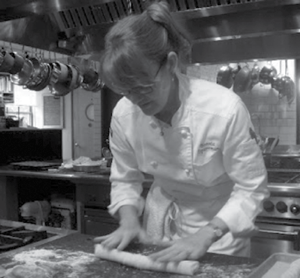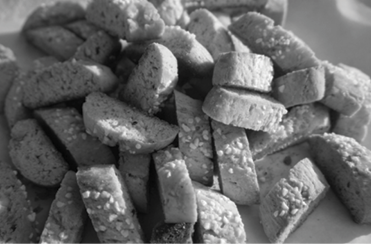Skorpa for fika
Now for a truly Scandinavian classic. Skorpa may seem elementary, but it is so delicious, it would be a shame to go without. This crispy, golden slice-of-a-cookie, is a delightful marriage of flavor and texture. It’s the perfect accompaniment to a cup of coffee or cappuccino; similar to its Italian cousin, biscotti, except it is more tender and easier on the teeth, thanks to the addition of butter.

When coffee and skorpor (plural) come together to be enjoyed in the company of others, this brings up another superb Swedish fundamental—fika! Some of the readers of Pietisten may be aware that fika, a word that crept into the Swedish language in the early 1900s, is formed by reversing the syllables of kaffe. Fika is an important part of Swedish culture. If you aren’t familiar with it, I am thrilled to introduce you to one of the most civilized phenomena on earth. Fika, (pronounced fee´kah), as the tray that holds my cup of coffee explains, “Is a social institution. It refers to any coffee break at work, or school, but might also be a date or a gathering of friends at any time of the day or evening.” It could be formal, but is more likely very casual. The word, fika, functions as a noun, as in, “We stopped for fika on our way home from the airport.” But it may also be a verb; “Let’s fika at Helena’s at nine o’clock.”
Traditionally, it refers to a cup of coffee or tea and a cinnamon bun or perhaps a little stack of pepparkakor. But, if one’s hunger is robust, no one will raise eyebrows if fika includes a meatball sandwich or a creamy Napoleon. The whole idea is to spend time with others to engage in meaningful conversation while enjoying a tasty treat.
Last year after landing in Stockholm, my husband and I went directly to a quaint konditori (coffee shop/bakery), to revive ourselves before driving several hours to our destination. Seated at a pine table, with a smooth patina that invoked many years of steady fikas, we hugged cups of strong coffee, and a cardamom roll each, and nearly cried with joy. It was our first fika of many that summer. Next, we continued down the road to greet a dear friend who is a banker. She jumped up from her desk to hug us, and immediately took us to the bank’s newly remodeled fika-room that was tricked out with a coffee machine, soda-stream, lovely dishes and a table topped with bright mid-century textiles. As in all Swedish businesses, schools, government offices, and hospitals, the work-day fika in such a room is customary. In fact, to not gather and converse with co-workers might be considered a faux pas.
Fika is not quite like our American Starbucks experience, although one could certainly fika in that place. A bona fide fika takes into account those with whom we share the ritual, where at Starbucks, a sequestered, solo experience is as likely as meeting friends. Fika can be handy if one needs to start, define, or end a relationship, because it is less intimidating than dinner. Or it might offer a delightful break on a journey with friends, taken along the side of a road. A basket of baked goods; perhaps skorpor, and a thermos of coffee under a tree, make a splendid fika.
As college students in Sweden, our days were punctuated by fika gatherings with fellow students and teachers. Sometimes fika was a formal affair, like the day an elderly teacher invited our whole motley crew into her beautiful dining room, where the table was laden with tiny cups, and generous platters of cake and cookies. Her fine skills as a hostess drew out the best manners we could muster, and we giggled at the gangly young men in our class, who clutched demitasse cups, with pinky fingers extended, playing up their enjoyment of a grand fika. During the normal school day, we fika’ed at ten and two. Even after supper, many of us gathered at eight in the evening to talk about the headlines of the day, over a cup of tea, and perhaps a crispy dried piece of cardamom bread, or knäckebröd with marmalade.

This reminds me, there are two distinct items identified by the moniker, skorpa. When cardamom rolls, or bread are no longer fresh, one may slice and toast the pieces in a warm oven until they are crisp. These are yeast breads. (See Pietisten, Spring/Summer 2015.)
The skorpa recipe presented here produces skorpor with a more tender crumb. It makes a generous batch of cookies that offer tremendous staying power. A jar of these on the kitchen counter or on an office desk, remain fresh for at least two weeks, welcoming all who need a little something-something with their coffee. Plus, skorpor freeze beautifully, for that day when unexpected guests appear and you need to pull fika-fare out of midair. One warning however, a slice of skorpa dipped for a half-second into a cup of coffee, and handed to a small child, may lead unsuspecting four-year-olds to desire coffee. I believe it’s a risk worth taking.
RECIPE: Cardamom Almond Skorpa

makes 75-80 cookies
1 cup unsalted butter
1 cup granulated sugar, (scant)
3 T. sour cream or plain yogurt
2 eggs
1 t. almond extract
1 t. cardamom, freshly ground
¾ cup slivered almonds, chopped and lightly toasted
3 ¼ cups all-purpose flour, (or 2 ¾ cups all-purpose flour, and ½ cup white whole wheat flour)
1 tsp. baking powder
1/8 tsp. baking soda
¼ tsp. salt
egg white for brushing the tops
pearl or turbinado sugar for decorating
Preheat oven to 350 degrees. If your almonds are not already toasted, lay the chopped nuts on a baking sheet and place in oven until they are lightly golden. (About 7 minutes.) Cool.
Cream butter and sugar together in a stand mixer. Add eggs one at a time. Add sour cream, almond extract and cardamom. Add almonds. Sift dry ingredients together and add.
Mix together on lowest speed just until the dough is uniform. If dough is sticky, chill.
Remove dough from bowl and divide into four portions. On a lightly floured surface, roll each portion into a log the length of a 12 x 16-inch baking sheet. Place two logs lengthwise on each parchment lined sheet. You will have two baking sheets with two logs of dough on each.
Brush each length of dough with egg white and sprinkle with pearl sugar. Bake for 20-22 minutes, or until dough begins to color.
Upon removing skorpor from oven, decrease oven temperature to 300 degrees. While they are still hot, slice logs diagonally cross-wise every half-inch.
Arrange skorpor on the baking sheets on their sides. Toast in oven for about 10-12 minutes. Flip them over, and toast again on the other side until they are golden brown. When cool, store in an air-tight container.
